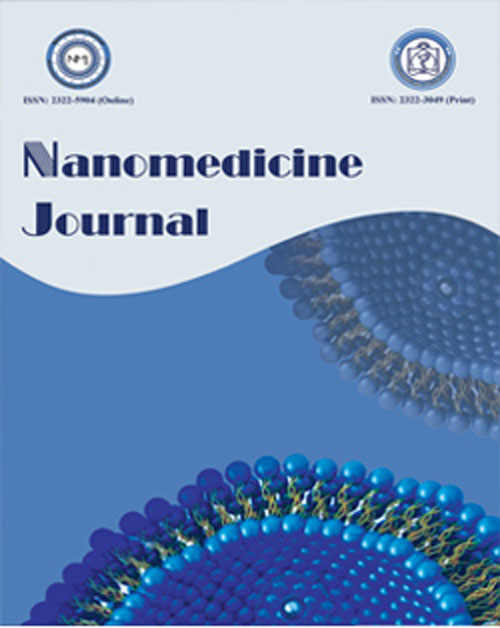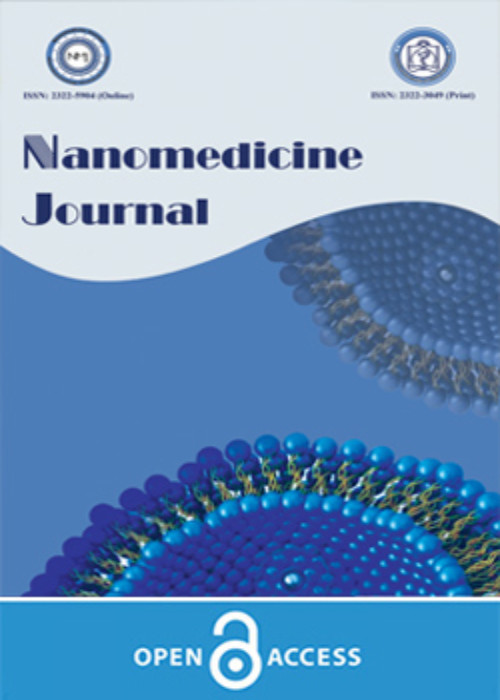فهرست مطالب

Nanomedicine Journal
Volume:5 Issue: 4, Autumn 2018
- تاریخ انتشار: 1397/08/01
- تعداد عناوین: 9
-
-
Pages 186-191Despite the prevalence of different kinds of wounds among people around the world, challenges ahead for managing wound healing continues. One of the most important issues for wound healing is infection that can delay healing process. Also, drug-resistant infections are growing as a worrying challenge in medicine. A lot of studies done over different methods to improve wound healing process, which in this regard, antibacterial nanoparticles have emerged to market for wound healing. Silver nanoparticles are the first kinds of nanoparticles that emerged in market as a wound dressing for wound healing and some of studies declared their clinical results for silver nanoparticles wound dressing for different kinds of wounds. In this review, we tried to browse clinical trials through using silver nanoparticles for wound healing to peruse the efficacy of silver nanoparticles dressing. The need for more study about efficacy and safety of silver nanoparticles is still a question.Keywords: Drug-resistant infection, Silver nanoparticles, Wound
-
Pages 192-198Objective (s): Titanium dioxide nanoparticles (TiO2 NPs) have been recognized as biologically inert material and have been used in a multitude of applications. Nevertheless, the negative impact on the human health is not yet well understood. Aim of the work: The study attempted to evaluate the epigenetic changes of the genome, in the form of DNA methylation in liver tissue samples, resulting from oral administration of TiO2 NPs (mixed rutile and anatase) in adult male albino rats. Furthermore, whether the Nigella sativa oil (NSO) can prevent the toxic effects of TiO2 NPs.Materials and MethodsThirty-two adult male albino rats were divided into four groups. (I) control, (II) nigella sativa oil, (III) TiO2 NPs and (IV) TiO2 NPs + nigella sativa oil. The impact of TiO2 NPs on the global DNA methylation and the oxidative status were assessed.ResultsAmong the study groups, TiO2 NPs exposure provoked oxidative stress; increased blood levels of MDA and decreased reduced glutathione (GSH) level. The global DNA methylation levels decreased after exposure to titanium nanoparticles. Significant differences were recorded between the control group and the group receiving TiO2 NPs. Marked improvement was noticed after supplementation of nigella sativa oil in terms of DNA methylation and oxidative stress markers.ConclusionOral administration of TiO2 NPs caused global DNA hypo-methylation in liver tissue samples. The epigenetic damage raises the concern about the safety associated with applications of the TiO2 NPs. The maintenance of DNA methylation patterns by Nigella sativa oil has a role in protection against genomic instability.Keywords: DNA methylation, Epigenetic, Nanotoxicity, Titanium dioxide
-
Pages 199-209Objective (s): The anti-fibrotic effect of chronic berberine (BBR) had demonstrated previously in a rat model of bile duct ligation (BDL). The aim of present study was to investigate hepatoprotective effect of BBR nanomicelles on liver cirrhosis induced by BDL in male rats.Materials and methodsAfter 21 days of drugs’ treatments, the serum and tissue levels of hepatic markers were measured and pathologic evaluations performed.ResultsBDL could markedly increase aspartate aminotransferase (AST), alanine aminotransferase (ALT), LDH, and total bilirubin (TBIL) serum levels and tissue tumor necrosis factor-alpha (TNF-α) level along with reductions in tissue levels of key antioxidants glutathione (GSH) and superoxide dismutase (SOD) as well as total protein. On the other hand, silymarin (100 mg/kg, p.o.), BBR (100 mg/kg) and BBR nanomicelles (50 mg/kg, p.o.) markedly decreased AST and ALT while enhanced GSH. In addition, BBR nanomicelles (50 mg/kg, p.o.), silymarin (100 mg/kg, p.o.) and BBR (100 mg/kg, p.o.) groups showed a considerable increase in SOD. BBR nanomicelles (50 mg/kg, po.) significantly lowered TNF-α. In addition, nanoBBR treatment prevented liver cirrhosis in histopathologic analysis.ConclusionFormulation of BBR may represent a worthy approach to enhance the effect of it in liver injuries.Keywords: Berberin, Bile duct ligation, Hepatoprotection, Nanoberberin, Oxidative stress
-
Pages 210-216Objective (s): SN38 is the prominent and effective anticancer drug for treating various types of human cancers such as colorectal, ovarian and lung cancers. SN38 is highly toxic, and due to its poor solubility in aqueous media, and low stability and hydrolysis at physiological pH, it has not been used as an anti-cancer drug. To overcome these problems, SN38 was conjugated with new nanocarriers in order to efficiently deliver it into cancer cells.Materials and Methodswe report the synthesis of nanocarriers based on covalent attachment of graphene oxide with β-cyclodextrin and coordinated with superparamagnetic iron oxide nanoparticles for SN38 loading and delivery. Using SPION-functionalized graphene oxide provides magnetic properties and local hyperthermia due to laser irradiation at 808 nm. Structures were characterized by using FT-IR spectroscopy and the size and morphology of the nanoparticles were determined using Malvern Zetasizer and FE-SEM, respectively.ResultsThe prepared nanoplatform was not significantly toxic to HT-29 cells. However, the developed graphene oxide-based nanocarrier containing SPION and SN38 was used to improve the chemotherapy through photothermal and photodynamic therapy. The optimal laser wavelength (808 nm) for PTT is consistent with that of IR-808 for PDT and the β-CD-GO-EDTA-Fe3O4-SN38 indicated synergistic effects of both drugs and SPION.ConclusionBiocompatible nanocarrier based on functionalized graphene oxide (β-CD-GO-EDTA-Fe3O4-SN38) demonstrated strong synergistic cytotoxic activity. The new formulation has a great potential as chemo-photothermal-photodynamic therapy agents in synergistic phototherapy.Keywords: Cyclodextrin, Drug Delivery, EDTA, Graphene oxide, SN38
-
Pages 217-221Objective (s): Artificial Neural Networks (ANN) are widely used for predicting systems’ behavior. GMDH is a type of ANNs which has remarkable ability in pattern recognition. The aim the current study is proposing a model to predict dynamic viscosity of silver/water nanofluid which can be used as antimicrobial fluid in several medical purposes.Materials and MethodsIn order to have precise model, it is necessary to consider all influential factors. Temperature, concentration and size of nano particles are used as input variables of the model. In addition, GMDH artificial neural network is applied to design a proper model. Data for modeling are extracted from conducted experimental studies published in valuable journals.ResultsThe dynamic viscosity of Ag/water nanofluid is precisely modeled by using GMDH. The obtained values for R-squared is equal to 0.9996 which indicates perfect precision of the proposed model. In addition, the highest relative deviation for the model is 2.2%. Based on the values of these statistical criteria, the model is acceptable and very accurate.ConclusionGMDH artificial neural network is reliable approach to predict dynamic viscosity of Ag/water nanofluid by using temperature, concentration and size of particles as input data.Keywords: Dynamic viscosity, Irrigant, Medical, Nanofluid
-
Pages 222-226Objective (s): Recently, the use of nanoparticles in medicine has increased for radiation protection purpose. So the aim of this study was application of nano Bi2O3 in prepared shield for dose reduction during medical imaging.Materials and MethodsNano Bi2O3 shield with 90% silicon and 10% nano Bi2O3 was prepared and dosimetry test was down in radiology by PTW DIADOS E dosimeter.ResultsThe mean dose without using nano Bi2O3 shields were 421 µGy, 733 µGy and 1110 µGy for 60, 80 and 100 kVp , respectively. After using 0.5 mm thickness of nano Bi2O3 shield dose reduction in 60, 80 and 100 kVp was 42%, 35% and 31%. A comparison between increasing energy from 60 to 100 kVp and dose reduction showed a significant reverse effect.ConclusionThe results indicate that the new shields containing nano Bi2O3 particles have a high X-rays attenuation ability but the attenuation property of the shields was decreased by the increasing of the energy. Based on the results, this new shield can help social health and decline the radiation risk.Keywords: Attenuation, Nano Bi2O3, Shields, Radiography
-
Pages 227-234Objective (s): Artificial bone implants have been studied as a possible bone replacement for fractured and destroyed facial tissue; the techniques employed to determine the success of the dental implants. The stability, porosity and resistance of the bone implant which is subjected to varying forces and stresses within the surrounding bone is a subject of interest among the dentists.Materials and MethodsAn experimental analysis was conducted on bio-nanocomposite scaffold using space holder methods. The reaction of the bio-nanocomposites deformation under load was determined using Abaqus software. Thereafter, an analytical solution was presented to express explicitly the deformation responses of the artificial bone implant.ResultsIt was seen that the vibrational behavior and mechanical performance of the sample containing 15 wt% additives have shown better mechanical characteristic compared to the pure specimen. On the other hand, the additive weight fraction has a significant effect on the compression test and porosity value. Also, the elastic modulus of the samples increases more than two times with the addition of additive (from 60 MPa to 145 MPa). From the results, it can be concluded that the highest vibration variation is seen in the sample with lower MNPs percentages.ConclusionBy observing the results of the stresses, it was seen that the stresses were in a small value in the bio-nanocomposites with highest amount of reinforcement.Keywords: Abaqus, Nanocomposite, Porous bone implant, Scaffold, Stress analysis
-
Pages 235-244Objective (s): This study aimed at investigation of preparation and stability study of Mitomycin and Mitomycin loaded nanoliposems and efficacy of the combination of Mitomycin -loaded nanoliposomes and Curcumin versus Mitomycin in suppressing HTB-9 and L929 cell lines, in vitro.Materials and MethodsAn HPLC method was validated based on Q2 (R1) International Conference on Harmonization (ICH) guideline for determination of Mitomycin in pharmaceutical samples. Soybean phosphatidylcholine (SPC) or hydrogenated soybean phosphatidylcholine (HSPC) mixed with cholesterol at 2:1 molar ratio respectively in two different groups to prepare Mitomycin nanoliposomes. Cell toxicity of free Mitomycin, Mitomycin loaded liposomes and curcumin was measured using MTT assay in bladder cancer cell line for treatment group and Fibroblast-like cell as control group. Also, propidium iodide staining was done to determine the level of DNA fragmentation.ResultsThe validated HPLC method showed stability based on the ICH guideline (n=3 and RSD<2%). Encapsulation efficiency values were 78 and 63 % for SPC and HSPC liposomes, respectively. Sizes of SPC and HSPC liposomes were 112 and 128 nm, respectively. Encapsulation efficiency of Mitomycin was 27 and 21 % for SPC and HSPC liposomes, respectively. Addition of Curcumin to the samples remarkably improved Mitomycin cytotoxicity. Concerning DNA fragmentation, Curcumin exhibited a protective effect when used in combination with Mitomycin.ConclusionSynergistic effects of Curcumin and Mitomycin were observed in terms of cell toxicity. Together, since Curcumin exerts anti-oxidative properties, its co-administration with a chemotherapeutic agent might protect normal cells from adverse effects of such drugs.Keywords: Mitomycin, Curcumin, Liposome, Combination therapy, Cytotoxicity
-
Pages 245-250Objective (s): Cerium oxide nanoparticles nanoceria (CeNPs) is a novel nanoparticle that has great potential for the treatment of various diseases. This study aimed to investigate the effects of CeNPs on oxidative stress biomarkers in the liver of male rats.Materials and MethodsTwenty-four male Wistar rats were equally distributed into 4 groups (n=6/each). The first group was controlled and the next three groups received CeNPs (15, 30 and 60 mg/kg/day), with an intraperitoneal injection (IP) for 7 days. After treatment, serum and liver tissue was isolated. ALT and AST concentration, total antioxidant capacity (TAC), total thiol molecules (TTM), interleukin 17 (IL-17), nitric oxide (NO) and TNF-α were measured.ResultsCeNPs 30, 60 mg/kg caused a significant increased NO (P=0.03, P=0.001), TNF-α (P=0.03, P=0.01) and IL-17 (P=0.04, P=0.01) levels, compared with the control group. Also CeNPs caused a decrease in the TTM (P=0.002) and increased MDA (P=0.04) in 60 mg/kg group compared to the control group. CeNPs 15 mg/kg significantly suppressed mainly the increase in plasma activities of aminotransferases (ALT (P=0.001), AST (P=0.01)), and liver IL-17 (P=0.01) and NO (P=0.02) concentrations compared to the control group.ConclusionThese results suggest that the effects of CeNPs are dose-dependent and at 15 mg/kg dose, it may have protective effects. Moreover, CeNPs in 30 and 60mg/kg doses showed immunotoxicity and oxidative effects in the liver.Keywords: Cerium oxide nanoparticles, Liver, Oxidative stress


